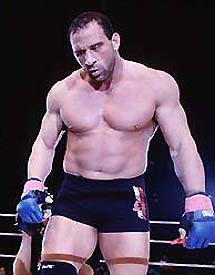UFC 12: The die is cast
The week before UFC 12 largely laid out the storyline of what the next several years for the promotion, as the company fought and lost the battle outside the cage.
After a law was passed in New York to legalize the sport a few months earlier, UFC 12 was set for Feb. 7, 1997, in Niagara Falls, N.Y., featuring a battle of former world class wrestlers for the UFC heavyweight championship.
Dan "The Beast" Severn, an Olympic alternate in 1984, was facing Mark "The Hammer" Coleman, who placed seventh in the Olympics in 1992, and came to UFC shortly after failing to make the 1996 Olympic team.
But the real story took place in the days leading to the show. The New York Times ran several days' worth of stories that turned the political tide against the event, decrying the sport, then known as no holds barred (the term mixed martial arts, created in Japan by pro wrestling promoters was not yet being used), or NHB for short.
The state assembly in New York, which had just voted to legalize the sport, after the articles blasting the legislature for doing so, voted 134-1 to reverse their tracks. The state senate drafted their own bill, which wasn't to ban the sport, but to allow local politicians the right to ban it within their jurisdiction. The senate voted 33-0 to pass the bill, which Gov. George Pataki vowed to sign. Since it was still legal that week, a few days before the event, the New York State Athletic Commission hastily created a 114-page rule book, completely changing the event.

Mark Coleman beat Dan Severn to claim the UFC heavyweight title.
(PRIDEFC.com)
Among the rules put in place were no submissions or ground work, and fighters would have to wear amateur boxing headgear. Worse, to make sure no such event took place that week even under those rules, they mandated that the octagon cage would have to be 40 feet in diameter. Since the promotion learned about this three days before the show, it would have been impossible to construct a cage to be built in time for the show.
UFC officials went to federal court the day before the show to get the rule book thrown out. U.S. Federal Court Judge Miriam Goldman Cedarbaum shocked the company by ruling against them, in a case where company officials convinced themselves it was a 100 percent lock they would win.
To save the show, they had to charter a jet carrying about 200 fighters, entourages, reporters, fans, and their octagon cage, from Niagara Falls to Dothan, Ala. Nobody got to their hotel rooms until 5 a.m. the morning of the event, and with a religious convention coming to the city that had booked up virtually every room in the city, they all had to check out by noon. They were still painting the octagon at 7 p.m., when the show was scheduled to start.
The cost of the last-minute move was $500,000, which was more than the profit margin of the show with pay-per-view buys continuing to decline. Because there was no time to advertise, fans were let in free at the Dothan Civic Center, and the company also had to refund strong advanced sales in Niagara Falls.
As for the main event, it only took Coleman 2:59 to finish the older Severn with a headlock choke.
The card also featured two four-man tournaments, including the creation of the under-200 pound weight class, which would eventually become the company's marquee light heavyweight division.
In the heavyweight tourney, Vitor Belfort of Brazil destroyed Tra Telligman in 1:16 and Scott Ferrozo in 52 seconds to set up a showdown that would never happen with Coleman for the title.
The first under-200 pound tournament champion was Jerry Bohlander, a Ken Shamrock protege from the Lions Den team, winning two matches by submission in a combined time of 1:57.
NOTEWORTHY
The man who beat Severn to win the 1984 Olympic slot at 220 pounds was Lou Banach, who went on to win the gold medal. In 1996, the man who captured the 220-pound slot Coleman was gunning for was Kurt Angle. Angle also won the gold medal. Angle now a pro wrestler, had made noise for years about going into MMA, but at 40, realistically, it's just talk.
Even though this was the first show with weight divisions, the company actually didn't have weigh-ins, and there was some conjecture that Bohlander, who won the under-200 division, may actually have weighed as much or more than Belfort, the heavyweight winner.
In the opening match of the show, actually the first match ever in the under-200 pound division, a fighter named Jackie Lee was billed as having a 98-0 record. He lasted all of 40 seconds before losing to Nick Sanzo.
RESULTS
Lightweight (under 200 lbs.) tournament
Alternates
Nick Sanzo def. Jackie Lee, TKO (strikes), 0:48
Semifinals
Yoshiki Takahashi def. Wallid Ismail, unanimous decision
Jerry Bohlander def. Rainy Ramirez, submission (rear naked choke), 1:24
Finals
Bohlander def. Sanzo (substitute or Takahashi), submission (strikes), 0:35
Heavyweight (200 lbs. and over tournament
Alternates
Justin Martin def. Eric Martin, submission (heel hook), 0:14
Semifinals
Scott Ferrozzo def. Jim Mullen, TKO , 8:17
Vitor Belfort def. Tra Telligman, TKO, 1:18
Finals
Belfort def. Ferrozzo, TKO, 0:52
UFC heavyweight championship
Mark Coleman def. Dan Severn, submission, 2:57 (Coleman wins former Superfight title).
